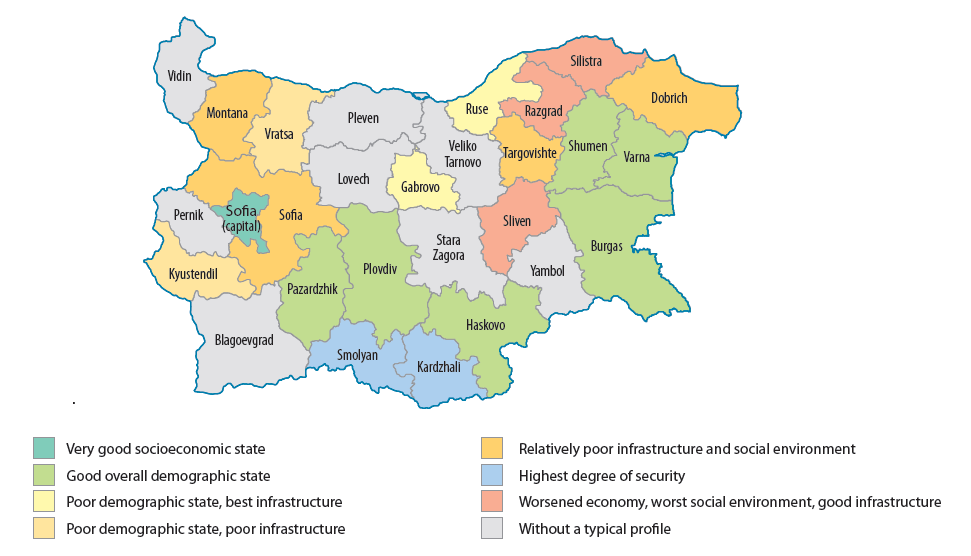Clustering of Districts According to Their Socioeconomic State
Assoc. Prof. Dr. Alexander Tsvetkov, Regiostat
An important task, when characterising regional development, is to find specific types of regional profiles which can help identify the differences and similarities between the districts by studying the joint impact of the indicators characterizing their socioeconomic state.
The complex indicators for the 12 categories of the analysis have been used as basic criteria when defining and structuring the regional profiles. These are: income and living conditions, labour market, investment, infrastructure, taxes and fees, administration, demography, education, healthcare, security and justice, environment, culture.
The cluster analysis of the districts’ state and development used so far, has been supplemented and enhanced. The outlining of the types of regional profiles has been done connecting factor analysis to neural networks. One advantage of factor analysis is its ability to reduce the initial set of indicators to a smaller number of summarised factors called main components. These factors are also called hidden because they are not obvious in the original array of indicators. Each of these hidden factors, or main components, can be considered as a set of sufficiently interrelated initial indicators, some of which have a leading and defining role in its formation. For instance, the initial complex metrics regarding investment, income and security define the Incomes and Security factor commented on further in the text.
The main components method allows to characterise the districts without significant loss of initial information and it allows certain typologies to be highlighted on the basis of hidden (not obvious prior to the reduction) factors - the main components. This enables the analysis of the districts’ state in terms of any hidden factor. Since the linear correlations between the factors are zero in using the main components method for factor analysis, it becomes possible to interpret the factors as independent, which in turn allows to show the share of differences (variations) between the districts, constituting the result of the effect of each hidden factor. The interrelations between the individual initial indicators are highlighted, which allows to analyse their mutual influences and the use of the latter as means of drafting effective policies.
The types of regional profiles, as well as the identified main components with their constituent initial indicators, can be used for identifying complex positive or negative phenomena, in disclosing and analysing the causes that have given rise to these phenomena, in formulating general or sectoral policies, etc.
Variances in the Socioeconomic State of the Districts
Four hidden factors or main components have been identified as a result of the factor analysis. Their relative influence (the share in per cent), when estimating the differences (the variance) between districts, and the defining initial indicators are presented in the figure below[1]:
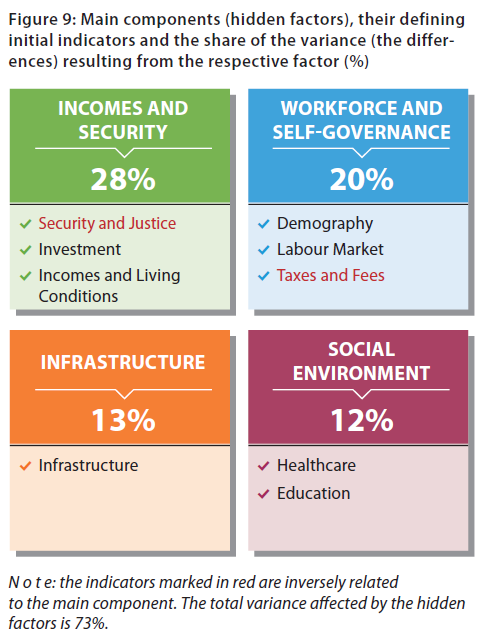
The order in which the factors are arranged demonstrates their relevance in outlining the differences between the districts. Economic development, measured via the Incomes and Security factor, is of primary importance. The quality of the workforce, the demographic potential and the abilities of local self-government to provide a favourable environment through the levels of local taxes and fees come second in terms of relevance – the Workforce and Self-government factor. The state of the infrastructure ranks third, and the state of the healthcare and educational systems comes forth – the Social Environment factor.
The first hidden factor – semantically interpreted as Incomes and Security – summarises the indicators for incomes and investments and defines nearly 30% of the variances between them. On the other hand, economic development turns out to be inversely related to problems of security and justice. It can be concluded from the data that investors are much more influenced by factors other than the level of security when deciding about an investment location.
The better one district performs in economic terms, the more problems it faces both in the functioning of the judicial system and the registered crimes against individuals and property.
The city of Sofia is the most developed district. In terms of incomes and investments, Burgas ranks second, and Gabrovo takes the third place, but the difference between the first and the second one is more than two times, while the differences between the districts that follow are much smaller. This additionally confirms the conclusions made in previous publications that Sofia (capital city) considerably differs from the rest of the country.
The state of justice and security affect the districts that occupy the bottom ranks – the ‘last’ two districts (Kardzhali and Smolyan) perform best in respect of security and justice. With regard to security and justice, Sofia (capital city) features the worst indicators.
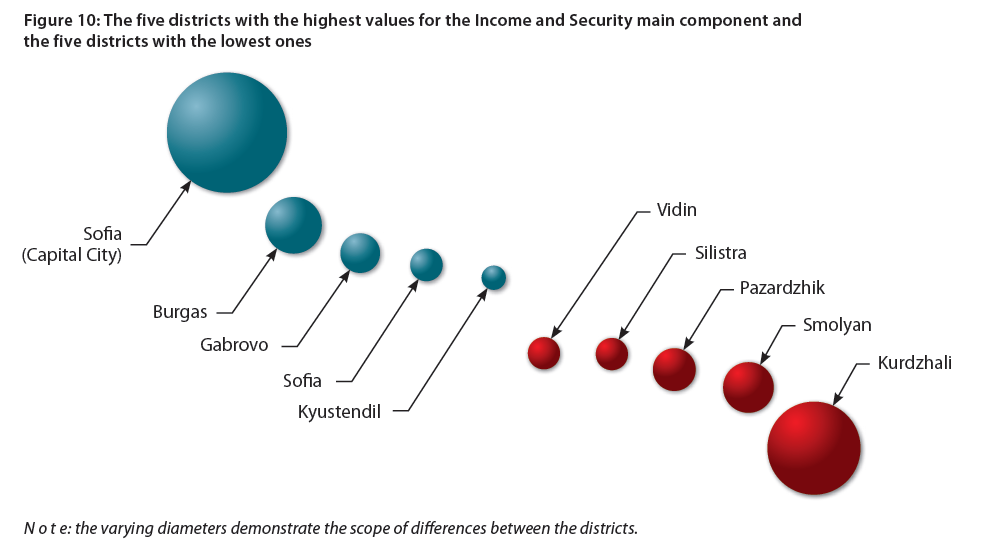
The demographic state, the labour market and the levels of local taxes and fees constitute the second factor: Workforce and Self-government. This factor affects about 20% of the variance between the districts. The municipalities located in districts where demographic states are relatively better (compared to the other ones, but affected by the generally unfavourable demographic situation) and so are labour market conditions can obviously afford higher local taxes and fees, which is why this indicator has been negatively correlated. On the other hand, the municipalities located in districts with worse demographic indicators and worse labour market situations strive to compete (where at all possible) with the rest by introducing lower taxes and fees. This approach currently does not have any significant effect, since the levels of taxes and fees constitute only one of many factors that influence both investment decisions and decisions for settling or leaving.
The differences between districts concerning this main component are not that significant compared to the first main component, as can be seen in Fig. 11 (please look at diameter differences).
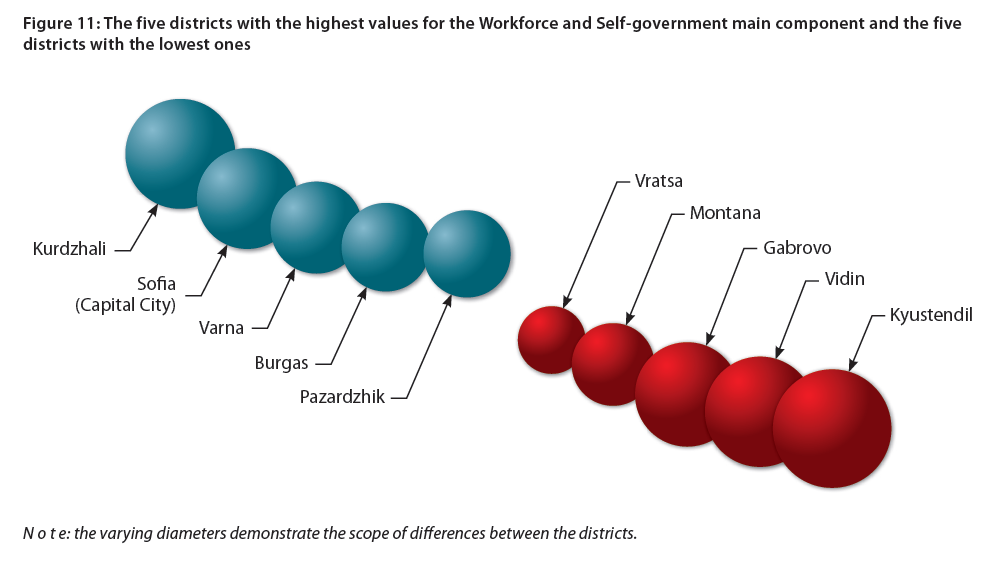
The Infrastructure factor is presented by a single initial indicator that represents the complex metrics regarding the state of the infrastructure. It is the cause for 13% of the differences between the districts.
The districts of Ruse and Gabrovo possess the best infrastructure. The districts of Razgrad and Silistra, which feature relatively poor social and demographic states, rank among the top five in infrastructure.
The infrastructure is in its poorest state in Vratsa, followed by Burgas. The differences are bigger than the ones concerning the Workforce and Self-government factor, but smaller than those concerning the first factor.
The differences between districts, in terms of this main component, are presented in Fig. 12:
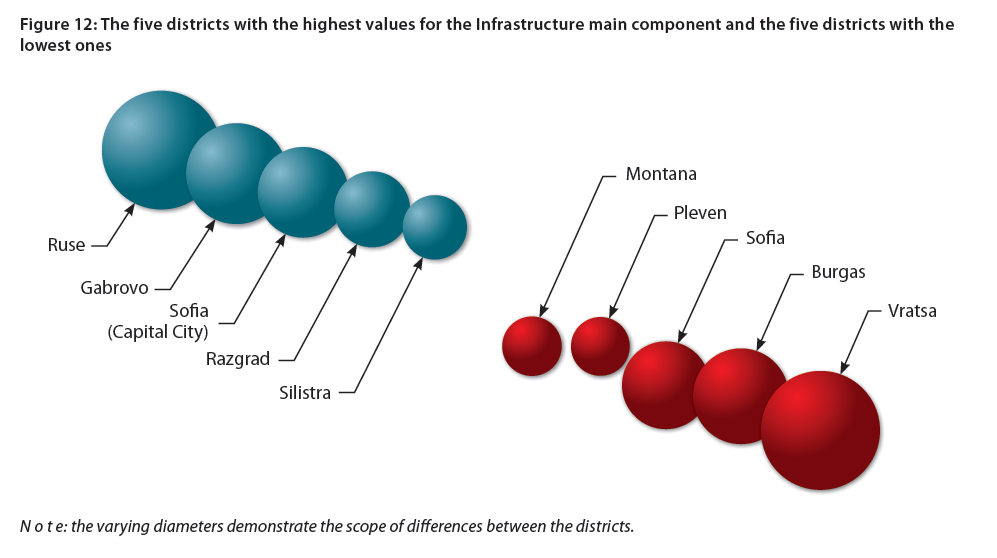
Lastly, the fourth hidden factor, interpreted as Social Environment, determines about 12% of the differences between the districts. It is dominated by the initial indicators for healthcare and education.
Here, differences are considerable, as with the first factor. Smolyan District is followed by Sofia (capital city), and the difference is double. The differences between the second and the following districts are not that big.
The districts of Razgrad, Silistra and Sliven feature the worst social environment in healthcare and educational systems.
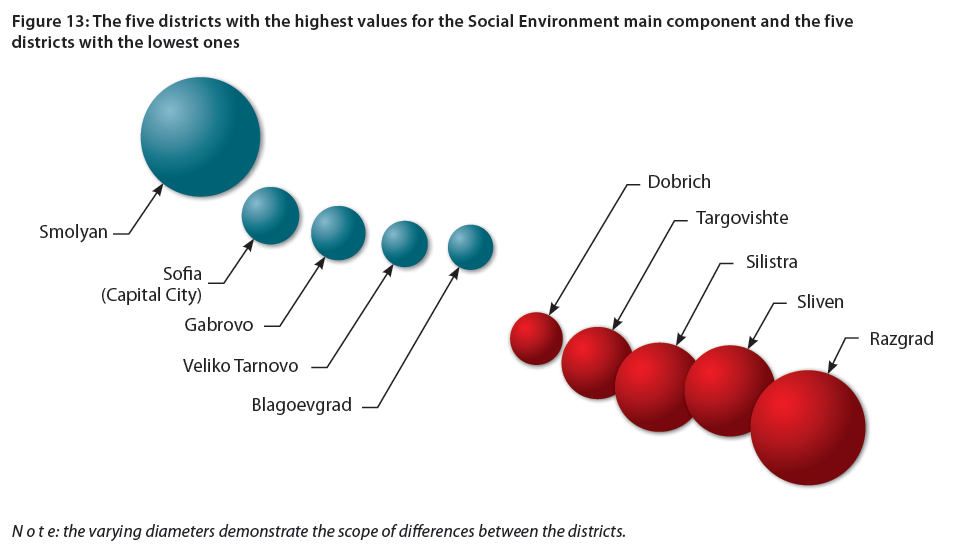
Types of Regional Profiles
After identifying and interpreting the four hidden factors, the main components, the neural networks method has been applied in order to outline the types of regional profiles. As a result 8 clusters, or types of regional profiles, are formed.
Although the number of clusters is the same when compared to the preceding two years, the methodological changes made should be taken account of when interpreting the clusters. Now the identified four hidden factors have been used for outlining the clusters, while in previous years the initial indicators had been used. Furthermore, there are changes in the initial set, and new indicators have been included.
Of course, there are differences in the clusters’ composition. The cluster consisting of Sofia (capital city) is the only exception, which has stayed the same for all three years of the monitored period (2012–2015). In analysing the types of regional profiles the emphasis was on showing what was typical and characteristic of the formed clusters, as in each field of analysis a detailed description of the overall socioeconomic state of the districts was provided.
The following types of regional profiles (districts groups/clusters) featuring varying socioeconomic states were specified as a result of the procedures completed via the neural networks method:
Very good socioeconomic state: the city of Sofia
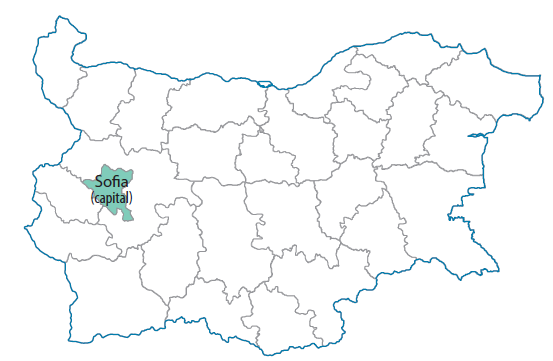 Once again Sofia (the capital) has formed an individual cluster. This cluster differs considerably from the rest since this is the most developed district socioeconomically.
Once again Sofia (the capital) has formed an individual cluster. This cluster differs considerably from the rest since this is the most developed district socioeconomically.
The cluster features the most developed economy (in terms of income and investment), the best general demographic state and the strongest labour market. The district is among those performing best in infrastructure and social environment (education and healthcare). It stands out as the only district with such characteristics.
The district has the highest GDP per capita. In 2012, the value of this indicator was two times higher than the following district (Sofia District) and almost five times higher than the one in the last district – Silistra.
The district features the highest average salary and the biggest investments as expenses for acquiring fixed tangible assets per capita and as foreign direct investments per capita.
The average salary in Sofia District (capital city) was 40% higher than the country’s average in 2013 and twice as big as the salary of the bottom ranking district – Vidin.
In 2013, the expenditure for acquiring fixed tangible assets per capita was 2.2 times higher than the country’s average and 8 times higher than the bottom ranking district – Vidin. Foreign direct investments per capita were three times bigger than the country average and 33 times bigger than the worst performing district (Montana) as at the end of 2013.
The district features the highest employment rate and also the poorest state in terms of security and justice – the number of registered crimes against property per 10,000 people was 60% higher than the country average in 2014. The actual workload of penal judges was also high (about two times higher than the country average in 2013).
Generally good demographic state: Burgas, Haskovo, Pazardzhik, Plovdiv, Shumen, Varna
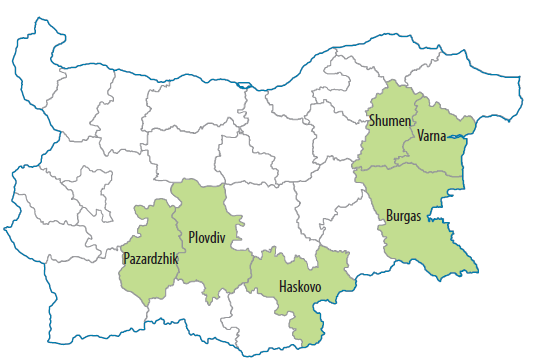 The defining characteristic of this cluster is the generally good demographic state. Three of the constituent districts in the cluster are among the leading ones in Bulgaria.
The defining characteristic of this cluster is the generally good demographic state. Three of the constituent districts in the cluster are among the leading ones in Bulgaria.
The districts in this cluster have a relatively low natural rate of decrease of the population and also a relatively good age structure. The levels of local taxes and fees are comparatively high in most of them.
The districts of Varna and Burgas rank 4th and 5th, and Plovdiv District ranks 7th according to the rate of natural increase of the population.
Varna District ranks 3rd, Pazardzhik District is 7th, and Shumen District – 8th, with comparatively favourable ratios between the population of higher age groups (65+) and the young population (aged 0-14, and 15–64 respectively), which still presupposes a relatively good but stagnating opportunity for population reproduction.
Most of the cluster districts have higher taxes than the country average regarding properties of legal entities, the tax on cars and vehicles and the tax on the transfer of properties.
Poor demographic state, best infrastructure: Gabrovo, Ruse
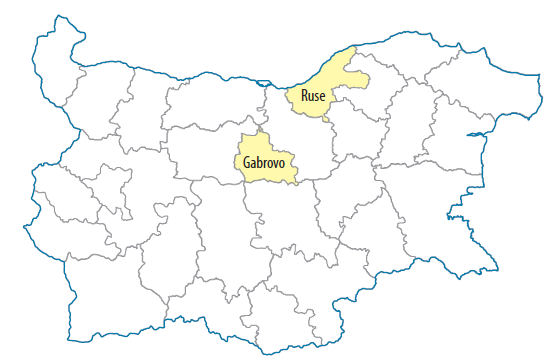
The poor demographic state of both districts – with a contrasing very good infrastructure – is typical for this profile. The districts of Ruse and Gabrovo rank first and second, respectively, among all others in infrastructure development. Only the districts of Lovech, Vidin and Vratsa feature poorer indicators in terms of demography compared to Gabrovo.
Another characteristicof the cluster districtsisthe lowest local taxes and fees.
Gabrovo District also has the most deteriorated age structure in Bulgaria. The ratio of the population aged 65+ toward the population aged 0–14 is higher by 60 pp than the country average. Only the districts of Montana and Vidin have a poorer natural increase.
Concerning the workforce, Gabrovo District has the second lowest coefficient of demographic replacement (the ratio of the population aged 15–19 to the one aged 60–64), which poses great problems in workforce reproduction.
Gabrovo District features the highest road network density, and Ruse District ranks second in terms of the railway network density. Both districts are among the top four in regard to the relative share of households with Internet access.
Ruse District has the lowest taxes on properties of legal entities and on cars and vehicles.
Poor demographic state, poor infrastructure: Kyustendil, Vratsa
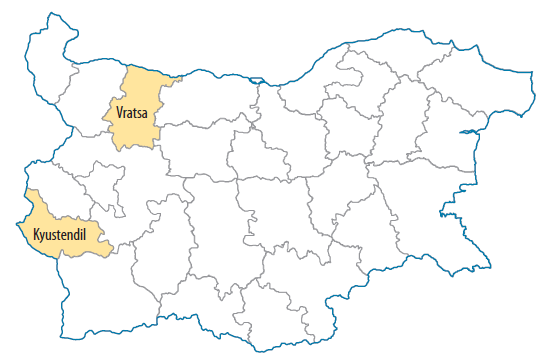
A poor demographic state coupled with poor infrastructure characterises this profile. Kyustendil District ranks last in general demographic state, and Vratsa District has the most deteriorated infrastructure.
Kyustendil has the third worst age structure – the ratio between the population aged 65+ and the one aged 0–14 was more than two times in 2014. Both districts feature low natural increase and negative migration balance. Vratsa ranks second, and Kyustendil ranks fourth in terms of the worst migration balance, i.e. more people leave than settle.
Both districts feature the smallest relative share of households with Internet access – it is lower by 20% than the country’s average and almost two times lower than the leading district, Sofia (capital city).
Vratsa District has the poorest quality of roads – barely 21% were in good condition in 2014, the country’s average being 40%, and 80% in the top ranking district – Sliven.
Relatively poor infrastructure and social environment: Dobrich, Montana, Sofia, Targovishte
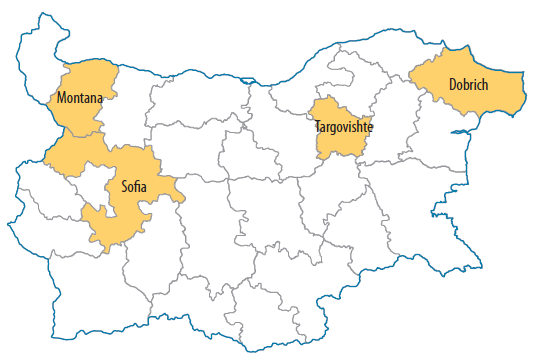
A comparatively deteriorated general state of both infrastructure and social environment characterise this cluster – the cluster districts perform below the country average with regard to both hidden factors.
Most of the cluster districts have poorer railway network density compared to the country average. The same applies to the relative share of people (aged 16 to 74) who have used the Internet for the past 12 months of 2014.
There is no college or university in Montana and Targovishte, and the number of students at colleges and universities per 1,000 people is lower than the nationwide figures. Dobrich, Montana and Targovishte are among the top districts concerning dropouts from primary and secondary schools.
Most secure: Kardzhali and Smolyan
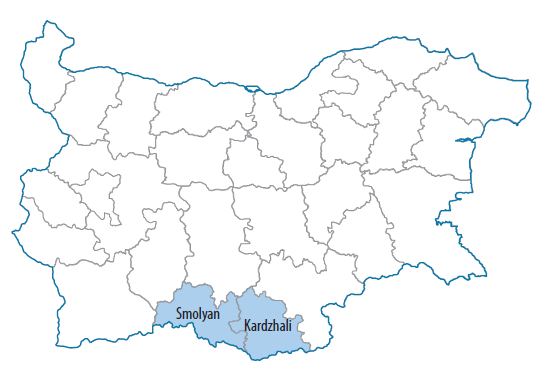 The cluster heading specifies its typical feature. The two districts that comprise the cluster are first, and second respectively, in terms of the general state of security and justice.
The cluster heading specifies its typical feature. The two districts that comprise the cluster are first, and second respectively, in terms of the general state of security and justice.
Kardzhali District was in a relatively good demographic state and in a generally good state of the labour market in 2014; Smolyan District featured the best social environment concerning healthcare and education.
Kardzhali District ranked first in criminal cases closed in the first 3 months (99% in 2013), and Smolyan District ranked fourth (96%). Both districts had the smallest number of registered crimes against individuals per 10,000 people among all other districts in 2014 – three times less than the country average and almost five times less than the district with the highest number of such crimes – Montana. The same applies to the registered crimes against property per 10,000 people of the average population.
Kardzhali District reported the lowest level of unemployment in Bulgaria and was among the best-performing districts concerning the employment rate in 2014.
Both districts topped the ranking concerning the number of teachers in primary and secondary schools per 1,000 students in 2014. Their number was higher than the country average by about a quarter and by 41% than the worst-performing district – Yambol.
The same also applies to the relative share of repeaters. In 2014 it was only 0.3% in Smolyan and 0.5% in Kardzhali.
In 2015 Smolyan ranked second, after Sofia (capital city), in average grade from state matriculation exams.
Deteriorated economy, the worst social environment, good infrastructure: Razgrad, Sliven and Silistra
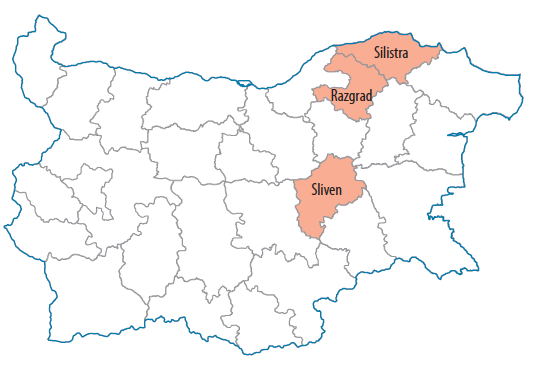
The poorest state of the social environment (education and healthcare) characterises this profile. The three districts the cluster consists of represent those with the most deteriorated social environment among all other districts in Bulgaria. The levels of income and investment per capita are also way below the country average.
On the other hand, the infrastructure condition is relatively good.
In 2015, Razgrad and Silistra feature the poorest grades from state matriculation exams – about 3.9 compared to 4.2 for Bulgaria and 4.6 for the leader, Sofia (capital city).
Sliven had the second biggest number of repeaters in 2014 and the biggest share of students that had dropped out of primary and secondary schools in 2013. In 2014, the district ranked second with the smallest number of teachers in primary and secondary schools per 1,000 students. In 2015, Razgrad ranked second in grades lower than 3.00 from the state matriculation exams. In 2014, Silistra was the district with the lowest relative share of the population aged 25-64 with university degrees.
In 2014, Razgrad District featured the highest number of people per general practitioner in Bulgaria, and Silistra – the highest number of individuals per specialist in Internal Medicine. Both districts were among the ones with the highest number of individuals per cardiologist – first, and third respectively.
Sliven District featured the highest infant mortality rate in 2014 – 15.4‰, and also the highest poverty level in 2012: 31.6%, compared to 21.0% for the entire country.
Silistra District had the smallest GDP per capita (in 2012) and the lowest income per household member in 2014: two times smaller than that of the best-performing district, Sofia (capital city).
According to the relative share of individuals aged between 16 and 74, who had used the Internet for the past 12 months, Razgrad ranked second following Sofia (capital city) in 2014; with regard to the quality of roads, Sliven District topped the ranking.
Lacking any specific profile: Blagoevgrad, Lovech, Pernik, Pleven, Stara Zagora, Veliko Tarnovo, Vidin and Yambol
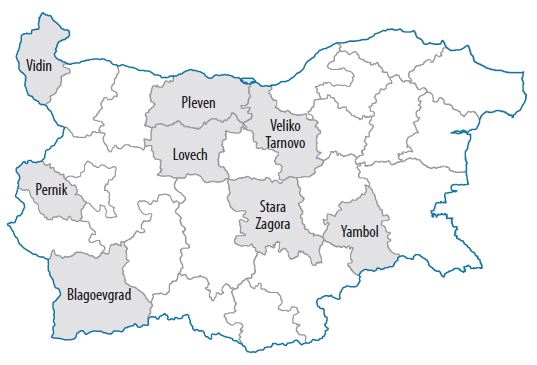
This cluster lacks any typical feature that would characterise it. The socioeconomic state of the comprising districts varies about the country average. Only Vidin District is an exception with one of the most deteriorated demographic backgrounds and one of the most depressed labour markets.
Vidin District had the most unfavourable ratio of the population aged 65+ toward the population aged 15–64 in 2014 and the second worst ratio of the population aged 65+ toward the population aged 0–14. This has caused extremely severe problems related to the ageing of the population and its reproduction. The district had the lowest rate of natural increase and the second highest rate of unemployment in 2014.
Summary
On the basis of the performed factor analysis for assessing the impact of various factors on the districts’ socioeconomic development and the clusters formed, the following could be summarised:
Sofia (capital city) stands out from the other districts in Bulgaria and tops the ranking in socioeconomic terms. Throughout the entire period of research, it has formed its own cluster with significant variances in the values of the indicators studied in comparison with the rest of the districts.
For yet another year the districts of Razgrad and Silistra have confirmed their poor socioeconomic state.
Both positive and negative characteristics regarding various aspects of the districts’ socioeconomic state – excluding the cluster of Sofia (capital city) – have been noted for all types of profiles. Sofia is the only district with a generally favourable socioeconomic profile.
The range of profiles featuring a poor socioeconomic state remains larger than the ones featuring a relatively good state.
Economic development is directly related to problems in the field of security and justice. Decisions about investment locations are much more influenced by factors other than the level of security and justice.
The approach of compensating poor demographic metrics by means of low local taxes and fees, via possible attraction of investors and settlers, has not brought any significant result. This could be due to the fact that the levels of taxes and fees constitute only one of many factors that influence both investment decisions and the decision for settling or leaving.
Appendix
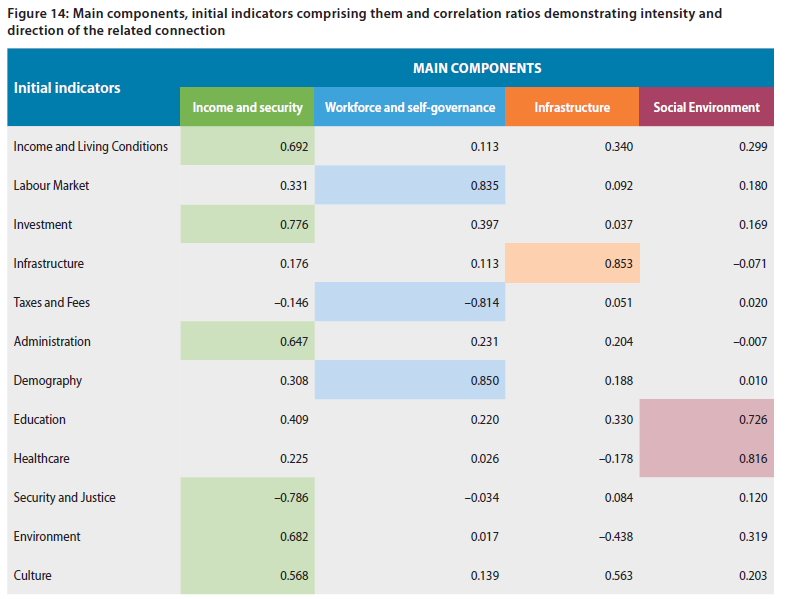
[1]The complete list of initial indicators, the comprising main components as well as the correlation ratios, demonstrating the intensity and direction of their relation to the initial indicators, are presented in Fig. 10 of the Appendix.
Latest news
Math talents on the edge of the map 30.06.2025
If you think that mathematics can only be taught and learned well in mathematics high schools or elite...
The municipalities need more own resources and a share of revenues from personal income taxation 26.06.2025
IME analysis shows opportunities for expanding municipalities' financial autonomy. The budget expenditures...
